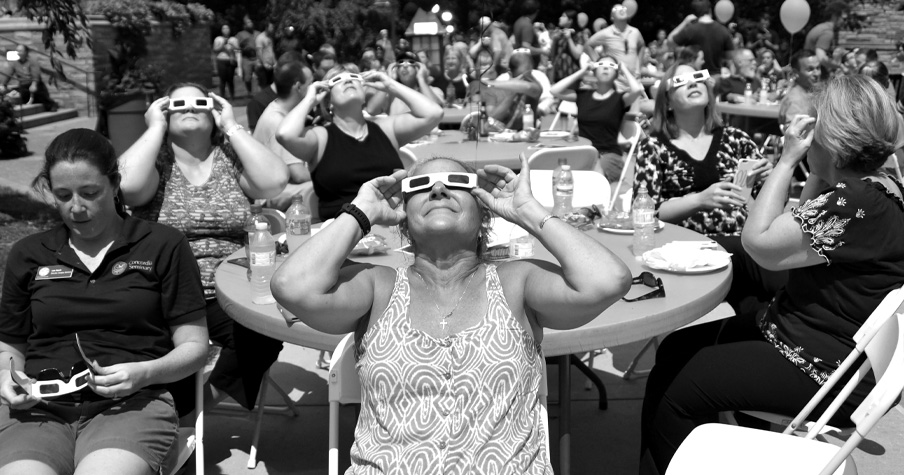
The Concordia Seminary St. Louis community celebrated a total solar eclipse in 2017 with a lawn party and Bible study on the wonder of God’s creation.
Total solar eclipses have always carried cosmic and spiritual significance – after all, it’s rare that the “the sun will be darkened, and the moon will not give its light,” (Mk. 13:24). Eclipse aficionados are gearing up for a big day on April 8, when a total solar eclipse will be just one of three seen in North America in the past half century.
The first – on February 26, 1979 – lost some of its visibility due to cloudy skies along much of its route through Washington, Idaho, and Montana, then Saskatchewan, Manitoba, Ontario, Quebec, and Nunavut (then the Northwest Territories). In a column published in the June 1979 Evangelical Recorder of Ontario Bible College and Ontario Theological Seminary (two precursors to Tyndale University), Assistant Editor Marlene Williams reflected on the event: “The moon and the sun are always there, going their appointed rounds day by day, quietly performing their God-intended functions ... apart from the few romantics and nature lovers, their beauty and regularity are scarcely noticed. But let the appointed round be interrupted – let the moon get in the way of the sun – and it is noticed, and charted, and televised!”
Thirty-eight years later, on August 21, 2017, the total solar eclipse was chronicled among all of those things, and more – posted, tweeted, livestreamed, and blogged. The path of totality this time cut a longer but narrower path all the way from Oregon to South Carolina.
Many places outside the path still witnessed a partial eclipse, including Austin, Texas, home of Seminary of the Southwest. “For us post-modern people, the total eclipse of the sun on the first Monday of the academic year evokes wonder,” Cynthia Briggs Kittredge, dean and president of Southwest, wrote on her blog. “It rekindles our capacity for awe in a demythologized universe.”
Just outside of St. Louis the 2017 eclipse lasted a full two minutes and 40 seconds, the longest time anywhere on the path of totality. Concordia Seminary in St. Louis took advantage of its privileged location and threw a party, inviting the entire seminary community to gather on Chapel Plaza to celebrate.
It also published a Bible study, “The Great American Eclipse and Our Creaturely Sense of Wonder”. Written by systematic theology professor Charles Arand and designed to be completed in one to three sessions, it invites congregations, small groups and individuals to explore the human “sense of wonder” in God’s creation through the contemplation of Scripture passages.
The April 8 solar eclipse will follow a path of totality from Texas up through Maine. This time around, Concordia St. Louis will be just a few miles outside that path of totality, but sky gazers at Seminary of the Southwest will have the chance to witness the moon passing in front of the sun for one minute and 44 seconds.
However you intend to reflect, study, or celebrate, it’s worth making the most of the event this April 8. The next total solar eclipse visible from North America occurs on August 23, 2044.